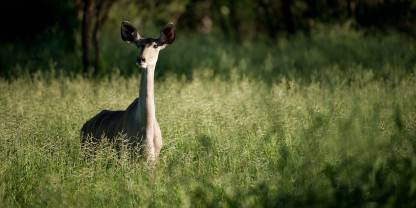Little-visited Banhine National Park is part of the Great Limpopo Transfrontier Conservation Area (GLTFCA). It plays a crucial role as a wildlife corridor, allowing animals to move freely from Kruger National Park in South Africa across the Mozambique border through Limpopo National Park and farther north to Zinave National Park. Due to heavy poaching in the past, wildlife numbers are still very low, but the reintroduction of several species is planned. The north of Banhine has beautiful wetland areas and offers spectacular birding.

-
Best Time To Go
- June to October (Better road conditions)
-
High Season
- Never (Little-visited park)
-
Size
- 7,000km² / 2,703mi²
-
Altitude
-
67-113m /220-371ft
 View Photos
View Photos
 View Photos
+24
Photos
View Photos
+24
Photos
Pros & Cons
- Off-the-beaten-track destination
- Beautiful scenery
- Fantastic birding
- There is very little wildlife
- Only one basic self-catering camp
- Remote and undeveloped
- Access is often difficult or impossible after heavy rain
Wildlife
Although Banhine is not a prime wildlife-viewing destination, the park has healthy populations of ostrich, impala, greater kudu, reedbuck, duiker, steenbok, oribi, porcupine and warthog. Predators such as leopard, serval and spotted hyena are present in small numbers. Buffalo can be seen occasionally, and recent research shows elephants using the ancient migration routes that have been restored by the GLTFCA. An extensive wetland area attracts a lot of waterbirds in the Wet season (November to April). Of specific interest is the high concentration of the endangered wattled crane.
Scenery
The scenery of this little-known park is quite spectacular. When Banhine was thriving in the 1970s, it was commonly referred to as the Serengeti of Mozambique because of its open grassy plains and big herds. Seasonal wetlands in the north of the park are fed by the Changane River. Unfortunately, access to this beautiful area can be restricted after heavy rains in the Wet season.
Activities
Banhine is mostly a self-drive destination for avid adventurers in 4x4 vehicles. Its lack of facilities is part of the appeal. There are no organized activities on offer, but you can explore the park independently on a limited network of roads. Bird-watchers should head out to the seasonal wetlands in the north of the park.
Weather & Climate
The weather and climate of Banhine is comparable to that of Mozambique in general. More info:
Best Time To Visit
The park is best visited in the dry winter months from June to October, when the grass is short and the roads are easy to navigate. Die-hard birders might want to visit in the wet summer months (November to April) when extensive seasonal pans fill up with water and host large flocks of cranes, pelicans and other birds. Note though that roads might become flooded at this time.
How To Get to Banhine NP
Banhine is northeast of Limpopo National Park, about 800km/500mi from the capital, Maputo. Access to the park is by 4WD vehicle only and it should be visited in expedition mode, ideally with two vehicles in convoy. Even in a 4x4, it is not advisable to visit in the rainy season (from November to April and into May) as the roads deteriorate badly at this time.
Health & Safety
Please read our malaria and vaccinations page for Mozambique and our general ‘Wildlife Viewing Safety Precautions’ for more info:

